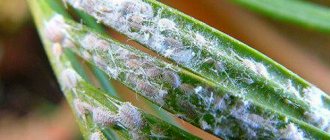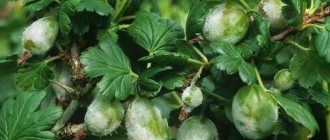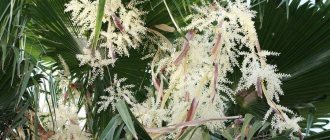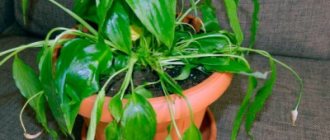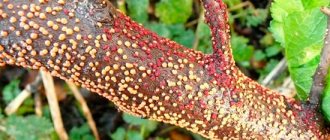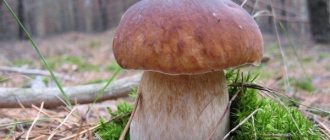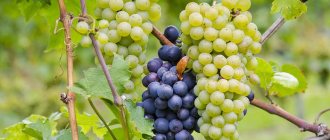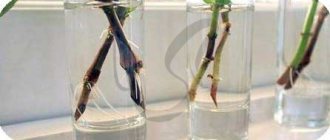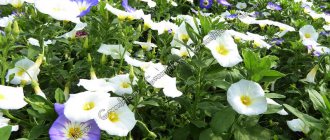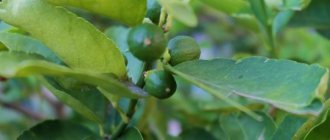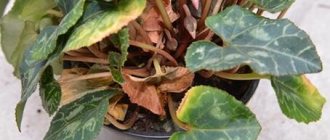Exotic cultures are often famous for their beautiful and unpretentious “character”. But, unfortunately, palm diseases at home cannot be called rare. Such a tragedy in the life of a plant is a consequence of improper maintenance of the flower. Therefore, the main task of the gardener should be to create a favorable microclimate, as close as possible to the tropical one. Initially, you should take care of air humidity, since the heat-loving tree does not tolerate dryness around the green mass. In 9 out of 10 cases, this is what leads to death.
Leaf dying is a natural process for most plants. In a palm tree, these scars form a majestic trunk. Nevertheless, its indoor varieties should be kept in a green state for as long as possible.
Carrying out preventive measures will help protect a small greenhouse from the harmful effects of pathogenic microorganisms. However, there are situations when plants still show signs of serious illnesses. Then you need to look for the reasons for their occurrence, and then organize a competent treatment session.
Infectious diseases of palm trees and ways to combat them
Infectious diseases cause a lot of harm to the plant, including wilting. The palm tree loses its charming appearance, turns pale, weakens and requires urgent measures to be taken to save it.
Infectious diseases can overtake a plant for various reasons:
- improper care;
- use of contaminated soil;
- planting a diseased sprout;
- infection from nearby plants.
Most often, various fungi become the causative agent of infectious diseases. To completely remove the fungus, you need to try hard.
Leaf spot
This type of infectious disease is caused by fungi. Spots appear on the leaves of the plant. They are predominantly round and oval in shape, can be of different colors (yellow, white, brown, light green, brown, gray), sometimes framed at the edges.
The size of the spots depends on the degree of fungal damage to the plant. With high air and soil humidity, the fungus multiplies very quickly. If measures are not taken in time, the leaves will completely wither.
The main causes of the disease include:
- excessive watering;
- increased air humidity;
- use of contaminated soil or sprout;
- hypothermia of the plant;
- the soil does not allow air to pass through well.
Control measures:
- trim damaged leaves;
- spray the plant with fungicides;
- moderate watering.
Spraying must be repeated 3-4 times every two weeks. In addition, to prevent the development of spotting, it is necessary to plant plants in time.
Palm penicillosis
The disease affects young leaves at the top of the plant. Dark spots form on them.
As the disease progresses, the size of the spots increases. After a week and a half, a white coating appears on them, which is formed by fungal spores. The leaves take on an ugly shape. The fungus starts in the soil and then moves to the palm tree. The main causes of the disease include:
- excessive watering;
- excessive air humidity;
- placing the plant in direct sunlight;
- use of contaminated soil.
Fighting methods:
- moderate soil and air humidity;
- remove the plant from direct sunlight;
- remove damaged leaves;
- treat with fungicides.
Root rot
This is one of the most common plant diseases.
The causative agent is a fungus. Root rot occurs due to excessive watering of the soil. The disease develops very quickly. At first the leaves turn yellow, then darken. Over time, the plants completely wither. Necrotic areas form on the roots.
The plant must be removed from the pot and all diseased roots must be cut off. Even slightly rotten areas must be removed. All damaged leaves and stems must also be trimmed. Then the plant is placed in a fungicide solution (Chomecin, Kuprozan).
This treatment will destroy fungal spores that could settle on healthy roots. Otherwise, there is a risk that the plant will continue to wither after replanting.
After 15 minutes, the palm tree is removed from the solution; it is recommended to sprinkle the cut roots with charcoal powder or a crushed black charcoal tablet. The plants are placed in a new pot with new soil.
Within a week after transplanting, the plant should be watered a little with a fungicide solution. Until the palm tree takes root in a new place and new young leaves appear, watering should be very moderate.
Stem rot
The disease is caused by a fungus.
The causes of the disease are excessive watering, large pressure drops, and insufficient fertilizer. The leaves become covered with dark wet spots, on top of which a white coating forms.
The disease develops quickly and leads to the complete death of the plant.
Fighting methods:
- removing all infected leaves;
- replanting a palm tree, as in the case of root rot.
Before planting in new soil, the palm tree must be treated with fungicides. After transplantation, until new leaves appear, the plant is watered very little.
However, in cases where the disease has severely damaged the plant, the palm tree cannot be saved. It should be thrown away along with the pot and soil.
The main fungal diseases of palm trees
Caring for a home palm tree is not difficult, but only if the gardener knows about the characteristics and needs of the tropical plant. Otherwise, the palm tree may be favored by pathogenic fungi - pests that provoke dangerous diseases and pathologies.
Alternaria and dry spotting
The causative agents are fungi belonging to the genus Alternaria. First of all, they affect the foliage, less often the stem; in tuberous plants, the tubers may be damaged.
Signs of the disease: spots on the leaves are brown, dry, with concentric circles. Gradually they turn black, grayish conidia become noticeable.
As a preventative measure, it is recommended to regularly ventilate the room. The following fungicidal drugs can be used for treatment:
- Abiga peak – 25 g per 5 liters of water.
- Oxychom - 10 g per 2.5 liters of water.
- Vitaros – 1 ml per 0.5 liter of water.
The crown of the tree is sprayed once every 1.5 weeks; 2-3 procedures will be required.
Read also: The best varieties of tomatoes for the Urals for greenhouses
Anthracnose
Pests are pathogenic fungi that may belong to the following genera: Colletotrichum, Gloeosporium, Kabatiella. It is worth noting that palm trees and ficus trees suffer from their activity more often than other indoor plants.
With anthracnose, foliage, petioles, stems are affected, and the fungus reaches the fruits.
Symptoms: leaf blades become covered with spots that look different depending on the type of pathogen. They can be small, round, reddish, brown or yellow. In any case, they grow and sometimes have a dark spot inside. The higher the humidity, the faster the pathogen spreads.
It is recommended to remove leaves with a modified structure, disinfect the soil and treat the seeds before planting. Affected palm trees should not be irrigated.
Anthracnose is treated with fungicides:
- Bordeaux mixture 1% - diluted according to the recommendations specified in the instructions.
- Copper sulfate - 10 g per 1 liter of water.
- Colloidal sulfur – 25 g per 5 liters of water.
- Abiga-pik – 25g per 5 liters of water.
Powdery mildew
A common contagious disease that quickly spreads from one indoor flower to another, so even large palm trees can suffer from it. The causative agents of the disease can be fungi from the genera Podosphaera fuliginea, Erysiphe cichoracearum and Oidium.
You can find out about a plant being damaged by the following symptoms: the leaf blades become covered with small powdery spots that can be wiped off with your fingers, but they appear again and become larger. Over time, they acquire a rich gray color. The leaves begin to dry out and the palm tree stops growing.
Experienced flower growers advise, during active flower growth, to carry out preventive treatments with sulfur and spraying the crown with whey, 3-4 times during spring and summer. In addition, palm trees should not be overfed with nitrogenous compounds, as this increases the risk of developing this disease. But phosphorus and potassium strengthen the green pet, making it more resistant to such fungi.
But what to do if a tropical tree still gets powdery mildew? The following antifungal agents are used for treatment: Pure Flower, Raek, Skor, the active ingredient of which is difenoconazole or Topaz containing penconazole. 2 ml of the drug is diluted in 5 liters of water and the green part of the plant is treated.
With a slight infection, a palm tree can be cured by spraying its foliage with a mixture of soda ash and copper sulfate. It is prepared according to the following algorithm:
- 10 g of soda dissolves in a liter of water.
- Add 2 g of tar or laundry soap shavings.
- 200 ml of water is poured into a glass, 2 g of copper sulfate is added to it.
- Both solutions are combined and water is added to a volume of 2 liters.
- The product is sprayed onto the sick specimen.
It is useless to use antibiotics to treat fungal diseases; drugs of this group are ineffective in this case. Bordeaux mixture also helps with powdery mildew.
Gray rot
If it is damp in a pot with a palm tree and the weather is hot, then you can expect a gray-olive coating with a edge to appear on the plant. The culprit of the disease is a fungus from the genus botrytis. Initially, the stem is affected, and later – foliage, flowers, and fruits.
Gradually, the affected areas become similar to dry rot, covered with concentric spots. The spots increase in size and ring the stem. Gray rot resembles a layer of mold and loose cotton wool.
You can prevent the development of the disease if you adhere to the basic rules:
- The soil should be disinfected before use - heated in the oven or microwave.
- Ventilate the room regularly.
- Remove dying foliage.
- Provide the palm tree with plenty of light.
When replanting a tree, it is recommended to water the soil with solutions of special preparations - Trichodermin, Barrier, Barrier or Fitosporin. If the plant is affected by gray mold, then complex therapy is required, consisting of a number of measures:
- Affected leaves are removed.
- The sections are sprinkled with charcoal or ash.
- Damaged areas can be lubricated with trichodermin paste - the powder is mixed with a small amount of water.
- It is recommended to spray the crown with special products - 0.1% Topsin-M or Fitosporin, diluted to the color of tea leaves.
The following drugs also help against gray rot - 0.2% Fundazol solution, a mixture of 0.2% copper sulfate and 2% laundry soap, Pure Flower, Skor, Raek. As a rule, repeated treatments are required, which are carried out every other week.
These are not all diseases that are caused by fungi, and the owner of an exotic animal should more closely monitor the condition of the pet. In addition, palm trees can also suffer from insect pests.
Diseases of palm trees with improper care and ways to combat them
The palm tree is unpretentious in care. However, failure to comply with the basic rules of temperature, watering and feeding conditions leads to plant diseases. Timely adoption of measures to eliminate errors in care will return the exotic beauty to a healthy appearance and active development.
is most detrimental to palm trees .
This leads either to excessive soil moisture and plant rotting, or to overdrying of the roots and insufficient nutrition. Subsequently, the palm leaves turn pale, become covered with spots, the plant weakens and fades over time.
Brown spots
They are formed as a result of excessively moist soil or the use of hard water for irrigation.
Such consequences can also be caused by a decrease in temperature at the location of the plant. The spots have different shapes and sizes. At first they are small and round, but later they grow and become angular.
. To overcome the disease, it is necessary to moderate watering, use settled water, and maintain room temperature in the room. All damaged leaves should be trimmed.
The lower leaves have turned brown
The lower leaves turn brown as they age.
During the life cycle of a plant, its leaves are constantly renewed: young ones bloom on top, and the lower ones become old and turn brown.
These leaves need to be cut off.
Old foliage still takes useful substances from the plant, so to ease the load on the root system and the development of new shoots, it must be removed.
The tips of the leaves have turned brown
The reasons why palm leaves turn brown are:
- dry air;
- insufficient watering;
- low temperature.
The spots on the leaves are dry in nature and grow in size very quickly. If you find such signs, you need to do the following:
- spray the leaves with water;
- normalize the watering regime;
- if the room temperature is below 18 °C, move the plant to a warmer room or place polystyrene foam or a piece of wood under the pot.
Round spots with a brown halo
This problem occurs when the plant is placed in direct sunlight.
The palm tree should not be exposed to open sun, especially in summer. The plant needs light, but direct rays of the sun burn the leaves. To correct the situation, the palm tree needs to be moved to another place where it will not be exposed to direct sunlight.
Date palm pests and diseases: don’t let the leaves dry out! How to rejuvenate a plant?
The decorative date palm has long gained popularity among home gardening enthusiasts. The plant has a very attractive appearance and can decorate any room.
However, there are a number of diseases characteristic of the date palm, as well as several types of pests. It is important to recognize diseases in time and know how to deal with pests.
Major diseases and shortcomings of care
Why do the tips of the date palm leaves dry out? Why do spots appear? Date palm ailments can be associated with both disease and poor care .
Fungal and viral diseases
Various pathogens
are to blame for date palm diseases :
Gray spot is the most common among fungal diseases . Signs of the disease are gray spots on the leaves, more so on older ones. As the disease progresses, black spots appear - these are fungal spores.
For treatment , it is necessary to remove all infected parts before the disease affects the entire plant. Next, the palm tree is treated with fungicides - special antifungal drugs. The same remedies are also applicable for another, no less common fungal disease - pink rot.
Bacteria lead to putrefactive processes. They are characterized by soft stems and leaves, which also become discolored and fall off. The appearance of bacteria is promoted by increased soil moisture and keeping them in a cold room.
If a mosaic-type pattern appears on the leaves, this signals a viral infection. Most often, the plant is infected by insects , which must be promptly destroyed indoors. They may be:
And other insects that can enter the room. For protection, mosquito nets should be installed on windows.
Reasons for the loss of decorative appearance
Soil oversaturated with moisture can cause brown spots . Watering with cold water also leads to the same result.
Softening of the trunk , coupled with a putrid odor, also signals excess moisture, which threatens the life of the plant.
To check, you need to remove it from the pot and inspect it. If dead roots are found, you need to separate them from living ones and thoroughly clean them. Replant into another pot and into drier soil.
Date palm leaves are drying up, what should I do? If watering is insufficient, the leaves begin to wither and turn yellow . This may also be due to poor quality water - too hard or low in essential microelements.
Brown coloring of the tips of the leaves is the result of insufficient air humidity. The same symptom is characteristic of hypothermia.
Diseases and pests
The red spider mite is one of the main enemies of not only the date palm, but also many other indoor plants.
The size of the insect is only half a millimeter. It is bred in rooms with extremely low humidity and high temperature. It starts first in the stem, gradually spreading to the leaves.
Symptoms include gray or yellow spots and cracks. If no measures are taken, the green pet will die, completely covered in cobwebs. Particular attention should be paid in the spring, this is the time of the most likely infection.
The mealybug parasitizes leaves and young shoots, from which it sucks the juice. As a result of infection, the plant slows down its development and almost stops growing. The main symptom is a solid, cobweb-like white coating.
Thrips parasitize leaves, especially in their lower parts, laying eggs inside them. Damaged leaves become gray-brown in color and turn white at the top. Thrips can kill a plant: first the leaves turn yellow and fall off, and then the entire palm tree dries out.
The scale insect also feeds on plant sap and spreads very quickly. Insects gradually cover the entire palm tree, its surface becomes like tiny scales. As a result of loss of juice, the foliage withers and turns yellow, and the shoots may dry out.
The common spider mite parasitizes more than 200 species of cultivated plants, including the date palm. The insect damages the epidermis of the leaf and feeds on the sap of the plant, as well as chlorophyll grains. The leaf blade gradually darkens and dries out. Without treatment and insufficient watering, the plant dies.
Date palm diseases: photos show how your plant can suffer from improper care or pests.
About pests affecting indoor palm trees
Scale insect and false scale insect
If the foliage of a palm tree is covered with tiny brown droplet tubercles, it means it has been attacked by a scale insect. The insect feeds on the fresh sap of the plant, depriving it of valuable nutrients and leaving pale areas underneath. In addition, scale insects secrete a sticky coating that looks like white dots.
These pests are much more resistant to insecticides than other insects, since they are protected by a special shell, so it is recommended to use intestinal agents against them. When eating the juice of poisoned leaves, the scale insect is paralyzed, which leads to its death.
In addition to treating with insecticidal preparations, you can treat the tree crown with an alcohol solution or a water-oil emulsion. Additionally, it is useful to replace the top layer of soil with fresh substrate.
There are also many folk recipes for removing these small pests. For example, you can rid a palm tree of scale insect larvae by the following means:
- Infusion of dandelion leaves and roots - 30 g of fresh raw material per liter of water.
- Potato tops tincture - 100 g of fresh herbs per liter of water.
- A decoction of tomato leaves and stems - 400 g of crushed mixture per liter of water, the composition is diluted 3-5 times.
- Garlic tincture - garlic cloves are crushed with a knife or crushed, filled with water: 150 g per 0.5 liter of water. Before use, the product is diluted - 5 g per liter of water.
As a rule, several treatments of the plant are required, and in addition, it is useful to use folk remedies for prevention.
Mealybug
Another unpleasant “comrade”, which is also a close relative of scale insects. He is also not averse to settling on indoor flowers and enjoying their fresh juice.
The mealybug is a 3-5 mm insect with an oval body, painted in a light tone. It reproduces at the “speed of light”; within a couple of days, the larvae of the mealybug can fill the veins, ovaries and even reach the root system of the palm tree.
To save any indoor plant, you should act immediately - the mealybug can destroy even a large palm tree in a short time:
Among the most effective folk remedies for spiderbugs, flower growers identify the following formulations:
- Infusion of tobacco leaves and stems – 20-25 g per 0.5 liter of water. Before use, it is diluted with water in a ratio of 1:2.
- Infusion of bitter pepper fruits - pour 100 g of crushed raw materials into a liter of water.
Hamedorrhea - home care
Hamedorea is a plant from the Palm family. In the wild, the palm tree grows in the tropical forests of Central America, Madagascar, and East Africa. There are frost-resistant varieties that are found in the Crimea, the Caucasus and southern Europe. In nature, there are more than a hundred species of chamedoria, but only a few are grown in culture.
More about the flower
In its natural environment it grows up to two meters in height, but in an apartment it becomes smaller and has erect and thin stems. The leaves collected in rosettes resemble bamboo. The flowers are yellowish and inconspicuous, having either the shape of spikelets or panicles. They are almost completely covered with leaves, so chamedorea is grown as an ornamental foliage crop. Palm trees look especially beautiful when 3-5 bushes are planted in a tub.
Flower care
Hamedorea is quite picky in its maintenance, but there are many nuances that must be observed for the successful cultivation and maintenance of this indoor plant.
Lighting
The palm tree feels great in diffused light. It is best to place chamedorea in a room with windows facing west or east. The northern orientation of the natural light source is also acceptable. The pot is placed on a stand or directly on the floor. If the flower is on a windowsill, excessive lighting will cause the leaves to lose their richness and brightness. On hot, sunny, warm days, additional shading is not required.
Temperature
Hamedorea does not like heat. The optimal temperature in the summer is from 22 to 26, and in the winter months - from 15 to 20 degrees. A decrease below +12 is considered critical. The palm tree does not tolerate sudden changes in temperature and drafts.
Humidity
The culture is able to grow in dry air, but for a short time. The tips of the leaves begin to turn yellow due to lack of moisture. To create favorable conditions, the palm tree is sprayed twice a day and a warm shower is given periodically. In winter, to avoid sudden drying of moisture on the leaves from heating devices, it is better to use a humidifier or place a container with wet pebbles next to the pot.
Watering
During the active growth phase, chamedorea is watered regularly, but only as the top soil layer dries out. It is better to underfill a palm tree than to overfill it. In the fall, watering is reduced, and in winter it is carried out no more than once a week. Take warm (room temperature) and settled water. If there is a filtered one, it is used immediately.
Priming
Hamedorea prefers to grow in heavy, slightly acidic substrate. To grow the crop at home, you can purchase ready-made soil for palm trees, to which charcoal is first added. Home soil is prepared from sand, peat, turf and deciduous soil, taken in a ratio of 1:1:3:1. A good drainage layer of expanded clay and broken brick is placed at the bottom of the pot.
Circumcision
The palm tree has one growth point. And if you start pruning chamedorea, it will stop developing and then die. Only leaves and panicle inflorescences that have turned yellow due to natural aging are removed. The latter do not look very attractive, but they take a large amount of strength from the plant for development.
Top dressing
From the spring months until October, the crop is fertilized every 2 weeks. Liquid fertilizers for palm trees are applied in the dosages specified in the instructions, and the concentration of complexes for decorative deciduous trees is halved. From October to February, feeding is reduced to once a month. In spring and summer, fertilizer can be applied along with watering or during irrigation, but reducing the dosage by half.
Transfer
The palm tree does not require much space. The tighter the pot, the more actively it develops. In the first three years of life, young chamedorea quickly gains growth, and therefore is replanted annually using the transshipment method. The event is held from early April until mid-May. It is not recommended to disturb adult specimens. The reason for changing the container may be pests or mechanical damage to the pot. The rest of the time, as a rule, they simply carefully update the top layer of the substrate, and do not touch the plant itself.
Reproduction
Hamedorea grown at home can be propagated vegetatively and by seeds. The last method is the most difficult. Purchased planting material has poor germination. To collect seeds, you need to let the palm tree bloom, which usually happens in 2-3 years and often depletes the plant. The seeds are soaked in a growth stimulator, and after 5 days the soft shell is removed. Slightly damages the hard bottom layer. Prepared seeds are sown in greenhouses - containers covered with film or glass. The soil is regularly moistened and ventilated. The first shoots appear within one to six months. It is impossible to speed up the process and determine how successful the event was until six months have passed. Adult palm trees are propagated by dividing the bush. Hamedorea is removed from the container and divided into individual plants along with an earthen lump. The divisions are transplanted into separate containers and provided with care that is no different from maintaining an adult specimen. Hamedorea is propagated by its offspring in the spring. The event is combined with a transfer. The shoots are separated only when the basal shoots have several well-developed roots. They are immediately planted in separate pots.
Diseases and Pests of Hamedorea
Problems that arise when growing decorative deciduous palm trees at home are associated with improper maintenance of the crop.
Diseases
Hamedorrhea can be affected by the following ailments:
- Withering of shoots.
Brown putrid spots with white spores form at the trunk, and the plant begins to wither. If the lesions are minor, double treatment with insecticides is sufficient. When the rot has completely engulfed the stem, it is no longer possible to save the plant. Hamedorea is thrown away. The pot can be left, but only if it is thoroughly disinfected with potassium permanganate. - Fusarium wilt.
Affects some shoots. They begin to fade, wither, and die. Fusarium does not damage the root system, so treatment with insecticides such as Fitoferm and Actellik can save the plant. When the damage is severe, the specimen cannot be saved. The container is treated with potassium permanganate or thrown away. You should work with gloves. - Anthracnose.
The leaves become covered with light spots, the color of which changes to brown, and the edges become convex and have a yellowish border. At first they are randomly located on the plant, and then merge. An anthracnose-infected specimen is treated with Rovral, and if this does not help, the palm tree is thrown away. The flowerpot where the palm tree grew is thoroughly disinfected.
When a palm tree turns into a pet zoo
Each plant needs special attention. For this reason, it is important to monitor your greenhouse closely every day. As a result, the florist will be able to notice the malicious pests of indoor palm trees in time. Often, parasitic insects differ in external characteristics. However, the harm they cause is almost the same.
Scale insect and false scale insect
If small tubercles/droplets (from 2 to 5 mm) of a brown hue appear on the leaves, it means that the scale insect has come to visit. Its diet is fresh plant juice. Because of this, the leaf area underneath them often becomes pale. If you remove them with your fingernail and crush them, thick yellow mucus will flow out from inside. Among other things, insects secrete a sticky coating in the form of white dots on the palm tree. Unfortunately, they can also appear on neighboring plants.
It is impossible to destroy the parasite with an insecticide, because it is protected by a dense shell. Therefore, it is better to use intestinal drugs. Ingestion of poisoned foliage leads to paralysis, and the scale insect eventually dies.
Some gardeners recommend treating the crop with an alcohol solution or water-oil emulsions. At the same time, you can replace the top layer of soil in the pot. Whether this will help or not largely depends on what stage of infection the flowerpot is at.
Mealybug
These insects are close relatives of the scale insect. Their diet is the same - the juice of the crop. They differ only in their oval shape (3-5 mm) and light color. The white larvae that appear on the palm tree quickly increase in number and begin to settle in:
When using sprays, you must follow the instructions. If you bring the sprayer too close, the concentrated product can damage the leaf blades.
Parasites secrete a waxy sticky mass. Due to their active life activity, palm growth slows down. As a treatment you should try:
- regularly collect larvae;
- remove severely affected leaves;
- every 7 days, wash the greens with a soap or alcohol solution (often mixed with onion or garlic juice);
- use lepodocides - preparations of biological origin with toxic substances;
- use systemic insecticides that are absorbed by the crop and poison all the tissues of the flower (the bugs eat them and then die).
Preparations with biologically active substances are applied only to infected areas, which are the habitat of the colony.
It is impossible to single out any universal drug or method of control. Often you have to experiment and apply several methods in turn. Nevertheless, experience shows that palm diseases can be successfully combated at home. It is only important to diagnose them correctly.
Read also: Marinated cabbage with mushrooms for the winter recipes
Fighting yellowing of leaves - video
Indoor palm trees perfectly complement the interior of any room. They bring a touch of exoticism, lightness, and fill the room with freshness and joy. However, unfortunately, these plants often get sick.
The article discusses the most common diseases and pests of palm trees, as well as ways to combat them. If you follow the basic rules of care and take timely measures to combat illnesses, you can ensure long-term healthy growth and the mesmerizing greenery of an exotic beauty.
Diseases of domestic palms
Convenient and lightweight Yula white/pink watering can for watering indoor plants
Certificate in electronic form or printed in A5 format
Large exotic plants are at the height of fashion - leading interior designers recommend including them in their interior. If you decide to buy a palm tree in a pot, you definitely won’t go wrong – this indoor beauty will give the room a fresh look, filling it with lightness and joy.
Unfortunately, palm diseases are not uncommon. This is partly due to improper care, partly due to easily spread pests.
In order to prevent the death of the plant in time and cure it, it is important to know the main diseases of domestic palm trees, their causes and methods of protection.
Diseases caused by improper care
Palm is a very unpretentious plant. However, with poorly organized care at home, the plant gradually dies.
An improperly organized watering regime is especially dangerous for domestic palm trees. If the substrate is over-wetted, the roots will rot. If there is insufficient watering, the roots dry out and the plant becomes deficient in nutrition. Palm leaves lose their green pigment, turn pale, and the plant takes on an unhealthy appearance.
To avoid mistakes in watering, we recommend purchasing a plant planted in a flower pot from the German manufacturer LECHUZA. The automatic watering system built into the flowerpot will protect the plant from the most common mistakes in care.
One of the signs of improper care is small brown spots on the leaves. They usually occur as a result of waterlogging of the soil, a high level of water hardness for irrigation, or low air temperature. To cure plants from brown spots, you need to adjust the watering schedule, use only settled water and adjust the air temperature in the room. Damaged leaves are cut off.
The lower leaves are brown. This is a natural aging process for domestic palm trees. No treatment is required here, you just need to remove the old leaves.
Brown leaf tips appear due to insufficient watering, dry air or low temperatures. Over time, they can grow throughout the entire leaf. To prevent this phenomenon, the palm tree is sprayed, the watering regime and temperature are adjusted.
Round spots with a brown halo are burns from direct sunlight. The palm tree is a light-loving plant, but is afraid of direct sunlight. Therefore, to prevent further spread of stains, the plant must be rearranged or shaded (for example, using blinds).
The most common ailments of palm trees growing indoors
It is important to devote a little time to preventive measures that will protect your tropical pet from possible illnesses and diseases. However, they are not able to 100% eliminate the possibility of developing diseases and then the palm tree will need emergency help.
Violation of the watering regime and consequences
Palm trees love moisture, but not excessively; when the soil is overwatered, the tree begins to rot. Overdrying the soil is also dangerous; in this case, the leaves of the plant become pale, covered with spots, their growth stops and the blades wither. To avoid this, you should care for your exotic beauty properly:
- The crown of the palm tree should be sprayed with warm water daily.
- It is recommended to regularly wipe the leaves with a damp sponge or napkin, moistening them and removing dust and dirt. Caution must be exercised when performing the procedure on specimens whose leaves are covered with a waxy coating or hairs. If the covering is removed, the leaves will die.
- For irrigation and other activities, soft, settled water, slightly lukewarm or at room temperature, is used.
If the rules are not followed, you may encounter alarming symptoms and deterioration of the plant’s condition.
The appearance of brown spots on the foliage
Pigmentation can be different, initially small spots “blur”, occupying increasingly larger areas, their round shape becomes angular. The most common reasons for this:
- Overmoistening of the soil, stagnation of moisture in it.
- Watering palm trees with hard, cold water.
- Keeping the plant at low air temperatures.
You can improve the condition of a green pet only by adjusting the conditions of detention and correcting care errors. The amount of water introduced is reduced by 2 times; it is preliminarily settled or filtered rainwater is used. Damaged leaves are removed.
The appearance of spots and drying of leaves also occurs when the tree is infected with insect pests - spider mites or scale insects. In the latter case, the palm tree will be covered with the finest cobwebby coating.
To rid the plant of uninvited guests, you need to treat its leaves with a strong solution of laundry soap and repeat the procedure after a week. If the infection is severe, you will have to resort to more powerful insecticides. For example, you can use the drug Actellica for treatment. The crown is processed, and after 7-14 days the event is repeated for prevention.
Darkening of the foliage gives way to a whitish coating
These are signs of the dangerous fungal disease penicillosis, which is also called “white leprosy.” It develops when a plant is infected by spores of pathogenic fungi living in the soil. Moreover, despite the fact that pathogens are in the soil, the top of the palm tree is the first to suffer from their activity.
